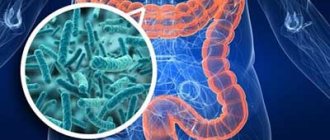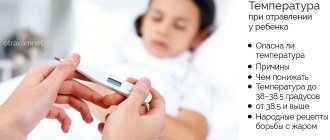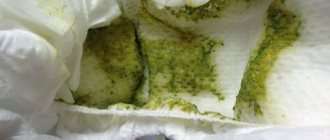It is known that severe vomiting in children always causes concern for parents, and if vomiting is also accompanied by fever... By the way, this is not a very rare occurrence. In children, fever and vomiting very often go hand in hand. Fever and vomiting in a child are not independent diseases, but symptoms of some unpleasant illness. Often, such a condition indicates diseases of the stomach or intestines, or the cause may be general poisoning of the body if there is an intestinal infection. Also, vomiting in combination with fever can be a symptom of diseases such as appendicitis, tonsillitis, influenza, as well as infectious diseases such as measles, rubella, scarlet fever. Of course, the final diagnosis for these symptoms can only be made by a doctor whom you urgently call at home. Parents, in order to alleviate the child’s suffering, can give him children’s paracetamol to lower the temperature and reduce pain. If the urge to vomit is combined with abdominal pain and a slight fever, then this may be signs of pneumonia or bronchitis. The same symptoms can occur with intestinal obstruction. So, the sooner the baby undergoes a full examination, the better. Occasionally, parents may observe inclusions of blood in the child's vomit. This can be either a symptom of a dangerous disease or the result of overstrain of the abdominal muscles during vomiting attacks. Do not forget that at the very beginning of the disease, your baby may vomit simply due to high fever. Such vomiting usually does not recur, even if the temperature does not drop for several more days. However, parents still need to continue to closely monitor the child’s well-being. If your baby gradually feels better, is cheerful and begins to play, then all the scary things are over.
Causes
The main reasons that can cause a child to have a fever, attacks of vomiting, as well as general weakness against this background:
- allergic reaction to various irritants (food, insect bites, wool);
- acute respiratory infections/ARVI;
- parasitic diseases;
- intestinal infections;
- acute poisoning;
- intestinal obstruction;
- appendicitis;
- angina;
- rotavirus infections;
- gastroenteritis;
- meningitis;
- gastritis;
- measles;
- scarlet fever;
- stress, overexertion;
- heatstroke;
- concussion;
- impact on the vestibular apparatus (attractions, trips);
- rubella;
- whooping cough;
- pyloric stenosis;
- flu;
- laryngitis;
- pharyngitis;
- tracheitis;
- bronchitis;
- pneumonia.
Vomiting in a child always occurs with these diseases; the absence of diarrhea indicates the severity of the disease, and also allows us to exclude some ailments. Only a specialist can determine the exact cause that caused such a reaction, so you cannot self-medicate.
Indications for contacting a medical institution
Child poisoning and vomiting may appear suddenly. If the disorder is mild, then the use of the sorbent may soon stop the negative effects.
But often severe intestinal infections with fever and vomiting require qualified medical care and treatment in a hospital setting, especially if the child is small.
You need to urgently call an ambulance if you have the following signs:
- bloody inclusions in vomit and feces;
- confusion, loss of coordination, fainting;
- traces of burns on the oral mucosa;
- respiratory and cardiac dysfunction, threatening cardiac arrest;
- severe muscle spasms;
- loss of vision.
It is important to understand that self-treatment in the development of a severe form can cause irreparable harm, so the child should not be given any medications until emergency assistance arrives. You need to try to remove vomit from the child’s mouth.
For laboratory analysis, it is necessary to save samples of the contents of the stomach and intestines (if vomiting is accompanied by diarrhea).
Features of some diseases
In order to provide the child with proper first aid, you should know the characteristics of the disease, which are accompanied by general weakness, malaise, nausea and fever.
- Appendicitis – no diarrhea, symptoms – fever, abdominal pain, sometimes severe vomiting.
- Childhood infections - fever, rashes on the body, intoxication, sore throat, presence of vomiting or the urge to vomit.
- Viral infections in a child are accompanied by pain in the throat during swallowing, runny nose, and high fever. Rotaviruses can be accompanied by diarrhea.
- Meningitis is characterized by an acute headache and a thermometer reading above 38.
- Bronchitis and pneumonia are also accompanied by cough and pain when taking a deep breath.
- Intestinal diseases are manifested by weakness, abdominal pain, dehydration accompanied by vomiting, which can occur several times a day.
If acute pathologies of the abdominal cavity are present, then vomiting and fever in 90% of cases are accompanied by diarrhea.
Read also: Vomiting without fever and diarrhea
Vomiting due to poisoning in a child (reasons)
To protect their child, parents need to know what can poison them. Determining the circumstances of the poisoning makes it possible to provide assistance before specialists arrive. The most common causes of vomiting are:
- Food products contain pathogenic microflora toxins.
- The food eaten is incompatible (leads to the formation of toxic substances).
- Unusual foods and new cooking technologies cause a negative reaction from the digestive organs.
- Chemical poisoning (drugs, mercury vapor, alcohol, household gas) upsets the functioning of the central nervous system and disrupts the normal functioning of digestion.
Carcinogens, heavy metals, toxic waste products of pathogenic microflora disrupt metabolism and irritate the gastric mucosa. A rapid increase in the concentration of irritating factors causes the need to evacuate the contents of the stomach, and convulsive contraction of smooth muscles occurs.
First aid
If a child is vomiting, accompanied by a fever, first aid is provided before the doctor arrives. An aqueous salt solution will help restore the balance of fluids and minerals. For a glass of water you will need 1 tsp. salt and 5 tsp. Sahara. It is prohibited to give:
- carbonated drinks;
- milk;
- chicken bouillon.
All of these fluids can cause severe dehydration. It is recommended to give adsorbents - Smecta or activated carbon - the amount is calculated according to the child’s age.
These symptoms are especially dangerous for a child under 1 year of age.
If a child refuses to eat food for more than 5 hours in a row, there is vomiting or the urge to eat, fever and other symptoms, a doctor’s call is required. Dehydration is determined by:
- prolonged absence of urination;
- pale and dry skin;
- rapid weight loss;
- retraction of the fontanel.
The nutrition of children over 12 months should be gentle. Allowed:
- pears;
- bananas;
- light porridge with water.
Completely abandon:
- fat;
- sweet;
- flour;
- fried.
Give an aqueous solution of salt and sugar 50 ml per 1 kg of weight. Antibiotics should not be used without a doctor's recommendation. Drugs against the background of vomiting and fever cause:
- dysbacteriosis;
- decreased immunity;
- addiction (decreased effectiveness in the future).
Antibiotics are prescribed by a doctor if negative signs persist for a long time. Additionally, a course of probiotics is prescribed, which restore the disturbed intestinal microflora. Therefore, conditions accompanied by vomiting and fever without diarrhea in a child should be monitored by medical professionals.
Medicines for poisoning
It is advisable to take simple activated carbon immediately after symptoms appear, or immediately after you discover that a bad substance has entered the baby’s mouth. If toxins do not have time to enter the bloodstream, the consequences will be easier.
If signs of poisoning and vomiting persist for up to three days, you should contact your pediatrician. Treatment is based on intestinal antibiotics and anti-diarrhea medications.
You should not prescribe drugs from this group on your own, as they have a strong effect on the body and should be selected in accordance with the cause of intoxication and the individual characteristics of the child.
Most often, antibiotics are prescribed for the diagnosis of salmonellosis and dysentery.
For botulism, treatment also includes a group of targeted antibiotics. A child aged 3 years or earlier needs to call an ambulance if the temperature rises to 38 or higher.
It is dangerous to take risks by prescribing medications to your child based on your own opinion. This is an unnecessary risk. At best, the medicine will not work, and at worst, it will only enhance the negative picture of the course of poisoning. Among the medications that can be given independently to reduce diarrhea if a child is poisoned are “Enterofuril”, “Loperamide”.
After the main symptoms, vomiting, fever, weakness and diarrhea, have subsided, you can start giving probiotics. They play an important role in restoring the intestinal flora after a shock in the form of poisoning.
With probiotics, the child will return to normal faster, the body’s natural protective functions will be activated and will help to recover faster. Probiotics are prescribed by doctors as an aid during recovery. They can be extended if necessary for a preventive period.
In case of poisoning, you need to create a correct diet. You can’t give flour, sweet and spicy foods. Sweet fruit juices and dairy products are prohibited in case of poisoning.
Treatment
Treatment methods depend on the cause that caused the negative reaction of the body. Attacks of vomiting, repeated 4-6 times a day, require intensive drinking, as it is necessary to remove accumulated toxins and restore the water-salt balance.
When a baby is poisoned, inducing vomiting is mandatory: it is necessary to cleanse the stomach of toxins, reducing their concentration. If diarrhea appears, then you cannot give medications to treat it, since this is an additional mechanism for protecting the body from poisons and toxins.
Some substances cannot be removed from the body by vomiting. In this case, it is better to give the baby an adsorbent. Eating is postponed until the symptoms of poisoning completely disappear.
If there are suspicions of other causes of poor health, then treatment measures can only be taken after consultation with a doctor. Diagnostic measures will help determine the exact cause and severity of the disease. Therapy and duration of medication is determined by the doctor after receiving the examination results.
How long does it take for it to appear?
The first clinical symptoms appear within the first 48 hours after poisoning . Since poisoning can be accompanied by severe dehydration, vomiting, in severe cases the number of vomiting can reach 10-15, it is necessary to remember and inform the doctor about the number of cases of vomiting and diarrhea .
Important! The incubation period most often lasts 8-12 hours, sometimes only 2 hours. If the correct actions are taken, the symptoms disappear within 2-4 days.
The acute period is usually accompanied by rapid development of the disease. Much depends on the type of toxin, the amount of toxic substance entering the body, and the speed of the metabolic process. Poisoning with individual substances that enter the body alone or together with food (poisons, household chemicals, alkaline, acidic substances) leads to an immediate deterioration in the child’s condition .
On a note! The duration of the latent period for botulism can reach 8 days.
When eating stale foods, clinical signs appear after 20-36 hours . Vomiting and nausea can begin after half an hour - this is how the stomach reacts to poisoning. The onset of a reaction after 4 hours indicates the penetration of a harmful substance into the intestines, after which the reaction “spreads” to the liver and pancreas.
The degree of intoxication depends on the speed of the body’s reaction : the faster it is, the less toxic substances penetrate the body.
Prevention
After vomiting stops and temperature levels return to normal, home treatment and prevention will be required. What is allowed to do?
- Create a light and nutritious menu - porridge, baked vegetables, white crackers, steamed cutlets, low-fat cottage cheese.
- Maintain bed rest - 1 - 3 days.
- Take medications to restore fluid.
- Drink raisin decoction, chamomile tea.
- Reduce stress – physical and mental.
For infants, the feeding regimen remains the same. Also, antipyretic, antiemetic, and painkillers can be prescribed for home treatment and prevention. It is recommended to maintain increased attention to the child's condition after the cessation of the main symptoms. Timely (according to schedule and age) vaccinations will help you avoid many health problems. You should not neglect taking vitamins and restoratives, as they allow the immune system to quickly cope with the load.
Diagnostics
The diagnosis of food poisoning is made by a pediatrician or infectious disease specialist after studying the anamnesis, complaints and clinical picture. They also pay attention to epidemiological data, the presence of group cases when eating the same food in the region.
Information about infection is obtained from biological fluids (vomit, feces).
If a generalized infection is suspected, blood is taken for bacterial culture.
For express diagnostics, tests are used: immunofluorescence (RIF), enzyme-linked immunosorbent assay (ELISA), polymerase chain reaction (PCR) - they are also important.
Sometimes, to establish an accurate diagnosis, the participation of additional specialists (neurologist, gastroenterologist, surgeon) is required.
Nausea and vomiting due to fever
Without going into details, I would like to immediately note that if a baby develops nausea against the background of a high temperature, then this is a rather serious symptom that requires the intervention of a medical professional. Vomiting causes dehydration in children, especially if it is repeated. What to do in this situation? In this case, the child vomits once, this can only be a protective reaction of his body to increased body temperature. To prevent complications, let your baby drink warm tea or juice, but in small portions. Drinking too much can trigger vomiting again, especially when the drink is very sweet. We will describe below how to properly feed your baby after vomiting.
First, let's find out why a child feels sick at a temperature of 37°C and above. There are two reasons for this:
• malfunction of the gastrointestinal tract, • the body gets rid of toxins.
You should know that these two reasons are closely related. Nausea and fever are always accompanied by painful conditions, but doctors mainly note the following reasons.
Conclusion on the topic
Health problems at a young age have a negative impact on both the physical and emotional state of the child. To avoid unnecessary worries, you need to establish trusting relationships in the family so that children can turn to an adult in any situation and explain what is bothering them at the moment.
You should not resort to drugs and doctors for any reason, but if you see that attacks of nausea are repeated and the child’s condition does not improve, consult your local pediatrician.
Source
Principles of pathology therapy
If vomiting bile was sporadic, you can do nothing - the condition will stabilize on its own. But if the attacks become more frequent, you need to visit a doctor and undergo the recommended examinations with your child. Based on their answers, the specialist diagnoses a functional disorder of the digestive organ. For treatment, the child will be prescribed suitable choleretic medications:
From folk remedies, children are recommended to make herbal teas, the components of which have choleretic properties. Immortelle, mint or angelica should be taken in the amount of 1 tsp, pour 200 ml of boiling water and cover for 15 minutes. Give the child 4 rubles. per day before meals. Single dosage – ½ cup. Course – 10 days.
How else can you help your child? Nutritionists advise giving the patient cool lime and cranberry juices. For frequent episodes of bilious vomiting, tea with ginger and cinnamon is helpful. You should not feed your baby products with caffeine during therapy. It is also necessary to abstain from tomatoes and citrus fruits - they irritate the gastric mucosa.
Daily meals should be portioned, that is, the child should eat little and often. You can’t have dinner right before bed, drink black tea, soda, or coffee. It is important to eliminate spices from your diet. It is advisable to sleep on your side.
- If a teenager is poisoned by alcoholic drinks, in addition to gastric lavage, sorbents are recommended (the drugs will remove toxic substances), a sufficient number of hours of sleep and a short-term fasting diet.
- Do not give fatty broths to a child who is vomiting. The first course should be dietary. You can prepare it from young chicken.
- To prevent dehydration, give your baby a decoction of rose hips, mint leaves and dried chamomile flowers. Give non-carbonated mineral waters.
Do not try to treat your child on your own without consulting a doctor. If the baby vomits, but there is no temperature, this condition is still dangerous. With repeated episodes, it causes dehydration and loss of consciousness. In this case, you cannot stay at home - the child requires hospitalization.
Vomiting in childhood is common. It is associated with immaturity of the digestive and immune systems . Vomiting of bile in a child occurs both on an empty stomach and after eating. The process of emptying the stomach is a protective reaction of the body, a response to an internal or external stimulus.
We recommend reading: Prunes for constipation: how to eat and brew correctly
Normally, there should be no bile in the stomach. Its casting can be one-time or constant. Observation of a child who has vomited has valuable diagnostic value and helps in choosing methods for examining young patients. Bile in the stomach is an unconditional reason to see a doctor.
From folk remedies, children are recommended to make herbal teas, the components of which have choleretic properties. Immortelle, mint or angelica should be taken in the amount of 1 tsp, pour 200 ml of boiling water and cover for 15 minutes. Give the child 4 rubles. per day before meals. Single dosage – ½ cup. Course – 10 days.
What not to do
Sometimes mistakes only make the situation worse, causing complications and delaying recovery. Therefore, you should follow the advice of doctors and remember that the child’s body will not tolerate experiments. What should you not do? The list is pretty simple:
- Do not give potassium permanganate to drink or make enemas from it.
- Do not rush with enzyme preparations.
- Do not give antiemetics.
- Do not prescribe medications yourself.
Often a child is given potassium permanganate as a drink. But you shouldn't do this. First of all, because it is difficult to accurately calculate the dosage, and it is not always possible to completely dissolve its crystals. In this case, they settle on the mucous membrane of the stomach or intestines, causing burns. Sometimes this leads to bleeding, perforation of the intestinal or stomach walls.
I heard a lot of advice about potassium permanganate, but when my daughter vomited after bad food, I did not dare give her such a solution. And when the doctor arrived and told me how potassium permanganate could be dangerous and why this was so, I was glad that I did not give it to the child.
Irina
Drinking potassium permanganate and enemas from it only create the appearance of relief, having a tannic effect. In fact, the body simply needs to get rid of toxins through vomiting or loose stools. But the use of potassium permanganate prevents this. Therefore, all pathogenic microorganisms and their toxins remain in the stomach and intestines and begin to be absorbed into the blood, aggravating the situation. Subsequently, the body is no longer able to fight them, and severe vomiting begins.
Enzyme preparations are good, but not on the first day of vomiting or diarrhea. First you need to get rid of harmful microorganisms and give the gastrointestinal tract a little rest. In the future, you can take enzyme preparations, but only as prescribed by your doctor. Still, it is better to stick to a diet and not load your stomach.
Antiemetics should not be given at the onset of vomiting. The stomach must be freed of all food that contains microorganisms that cause poisoning. Moreover, this will allow a minimal amount of them to enter the intestines. And self-prescribed drugs are simply dangerous for the child.
Read also: The child feels sick and vomits: the causes of the illness and what needs to be done
Please note that when the temperature rises, it is better to use candles. They will act immediately, bypassing the stomach, where vomiting will not give a chance to be absorbed. When giving medications prescribed by a doctor, it is advisable not to combine them with sorbents. It is better to wait several hours between taking them, otherwise the sorbent will minimize the effect of the drug.
How to lower your temperature
When a child’s temperature rises steadily after poisoning, parents usually panic and do not allow the body to cope with the problem on its own. If food residues have been eliminated from the body as much as possible, a sorbent has been taken and medical assistance has been provided, it is not recommended to lower the temperature of a child in case of poisoning, if the readings have not reached 38.5.
Algorithm of actions:
- It is necessary to understand that in case of poisoning, a child may have a fever and this is a sign that the immune system has begun to work. It is necessary to ventilate the room, ensure air circulation and maintain humidity within normal limits.
- Wipe the child with a weak vinegar solution (the temperature of the liquid should not differ sharply from body temperature).
- Taking antipyretics based on age. If vomiting occurs, rectal suppositories should be used.
- Give activated carbon or other sorbents according to age.
- If the situation cannot be stabilized, you should immediately call an ambulance.
Important! Before rubbing with vinegar, it is necessary to take into account the presence of convulsions in the anamnesis; if any, rubbing is contraindicated.
Treatment of poisoning with fever and prevention
Before treating poisoning with fever in a child, you should read the instructions for taking antipyretic drugs. All actions aimed at reducing indicators are carried out only after the thermometer shows 38.5. The values should be monitored throughout the illness, since hyperthermia in a child is a source of danger.
If the actions are performed correctly, the child will recover within the next day.
The question of how long the temperature lasts during poisoning in children cannot be answered unequivocally, but if it lasts for more than three days, the algorithm for further actions should be discussed with a doctor.
Treatment tactics:
- Abundant fluid intake.
- Taking sorbents (Atoskil, Enterosgel),
- Antibiotics (Augmentin, Gentamicy) and antimicrobial agents (Nifurocazide) as prescribed by the doctor,
- Antidiarrheal drugs (Smecta).
- Probiotics.
- Diet.
Important! It is prohibited to administer a course of medication without a doctor's prescription.
Small children are not able to fully take care of themselves; for this purpose, mothers are given maternity leave. Paradoxically, the peak of poisoning occurs in the first three years of a child’s life.
Control over food and hygiene must be thorough:
- Hands must be washed before each meal, after using the toilet, visiting public places, and contacting pets.
- All kitchen utensils must be clean at all times.
- Vegetables and fruits must be washed and doused with boiling water before eating.
- The food in the refrigerator should be periodically reviewed and inspected. All food of questionable freshness is thrown into the trash.
- Before offering water to your child, you should boil it.
- Mushrooms are not allowed for children to eat.
- The first aid kit with medications is stored out of the reach of children.
- When purchasing dairy products, it is important to pay attention to shelf life and sales.
- You should not prepare perishable foods for future use.
- Purchasing any food products at spontaneous markets is unacceptable.
What is vomiting
Vomiting is a reflex contraction of the muscles of the gastrointestinal tract that occurs to empty the stomach and esophagus. A reflex spasm in a child can occur for several reasons:
- poisoning;
- dizziness;
- binge eating;
- disturbances in the functioning of the stomach;
- infection;
- excitement (stress).
In infants in the first months of life, vomiting may occur after each feeding; this phenomenon is called “regurgitation.” This process is normal from a physiological point of view. It should be completed by 6-8 months of the child’s life. By this moment, the formation of the gastric sphincter is completed, which in the future effectively retains food, preventing it from entering the esophagus.
Etiology
The group of causes of vomiting in children includes pathological conditions, among which it is worth highlighting:
- congenital anomaly of the stomach - pyloric stenosis;
- pylorospasm;
- acute inflammatory process in the appendage of the cecum;
- intestinal obstruction;
- acute form of gastritis, which has a large number of its own predisposing factors;
- congenital or acquired pathologies associated with the gallbladder;
- varicose veins of the esophagus;
- development of portal hypertension;
- pancreatitis – in this case, the child will experience diarrhea and vomiting without fever;
- malignant neoplasms in the brain;
- a wide range of traumatic brain injuries;
- a sharp increase in intracranial pressure;
- insufficiency of the adrenal cortex, which often has a congenital form;
- severe diabetes mellitus;
- acute heart failure;
- kidney pathologies;
- intestinal flu;
- intestinal dysbiosis;
- dysentery;
- acute abdomen syndrome;
- pathological influence of pathogens or parasites;
- meningitis and epilepsy;
- rotavirus infection;
- ARVI;
- purulent otitis;
- metabolic disorders;
- disorders of the central nervous system;
- pathologies of the cardiovascular system;
- cardiospasm and pyelonephritis;
- esophageal diverticula and GERD;
- food allergies or poisoning from low-quality food products;
- migraine and intussusception.
Acute abdomen syndrome in children
If a child has a stomach ache and vomiting, this does not in all cases indicate the progression of a particular disease. The occurrence of such symptoms may have less serious causes. These include:
- Poor nutrition – consumption of food that does not correspond to the age category of the child. For example, eating excessively fatty foods by a three-year-old child;
- banal overfeeding;
- the presence of bad habits - most typical for children over thirteen years of age;
- a sharp change in climatic living conditions;
- sunstroke;
- pregnancy, which can occur from the age of fourteen;
- motion sickness in a car or other transport;
- severe fear - leads to nausea and vomiting at night;
- drug overdose;
- the impact of stressful situations at school, kindergarten or within the family;
- treatment of cancer tumors with radiation or chemotherapy.
In addition, vomiting during teething in children is considered completely normal.











